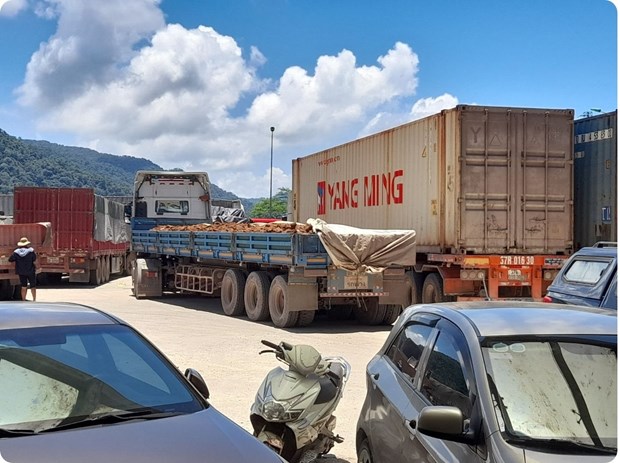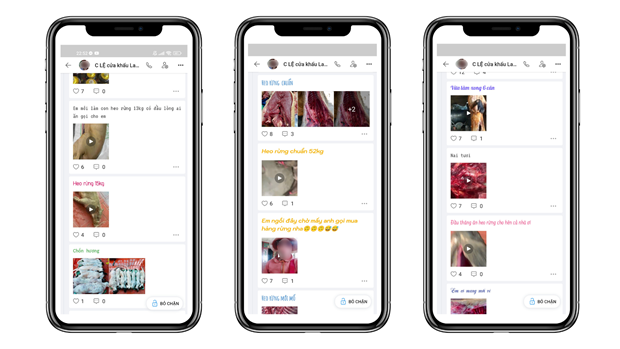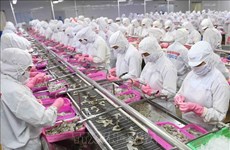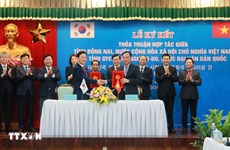Cross-border wildlife trafficking rife in Laos, Vietnam
Hanoi (VNA) – Tigers, bears, northern Chinese boar, pangolin and small Indian civet are cut into small pieces, each weighing 2-10 kilogrammmes before they are transported to Vietnam via buses.
Besides transport costs, sellers must cover a lubrication payment from 500,000 VND to 2 million VND (20.56-82.22 USD) for the “forbidden” products to be successfully transported to Vietnam.
VietnamPlus reporters got the information on the tricks to traffick wild animals from Laos to Vietnam by traders and coach service providers along Hanoi-Vinh-Quang Binh-Quang Tri-Vientiane.
Cross-border smuggling of wild animals is a complex business, amidst the ban on the illegal trade and risks of infectious disease transmission.
While having lunch at a restaurant in Salavan province, we were informed about the tricks that traffickers use to smuggle wild animals to Vietnam.
Lan, owner of a restaurant in Huong Khe district, Ha Tinh province, divulged that although competent authorities have enhanced stringent management, there are ways to transport wild animals cross the border successfully.
“There is no problem if you bring two to three kilogrammes of frozen wild boar and several squirrels to Vietnam. I deliver wild animals to Vietnam through truck drivers on a regular basis”, she said.
Lan sent a large amount of the animals to Vietnam as we counted nearly 30 trucks and containers, each trafficking two to three kilogrammes of wild animals, moving from Laos to Vietnam.
 Trucks and containers carry wild animals from Laos to Vietnam.
Trucks and containers carry wild animals from Laos to Vietnam.
Before we left, Lan asked whether we want to buy some game meat as the region boasts a wide range of wild animals, from squirrel and to
wild boar and pangolin.
The owner of Souriya hotel in Khamkeut district, Bolikhamsai where we stayed also spilled the beans about how traffickers transport wild animals from Laos to Vietnam.
“You can carry several frozen squirrels via border gates. However, with a large amount you should send them via coaches that run from Laos to Vinh city”, he said. He gave us the contact of Thiet Nguyet coach service provider.
We then called Thiet Nguyet to ask whether they send 40 kilogrammes of frozen game meat of a wild boar, a small Indian civet, squirrels, and a clouded monitor to Vietnam. The owner, named Nguyet, was reluctant to accept at first, given tight control byauthorities. Then she offered a transport fee of 300,000 VND for ten kilogrammes, and a lubrication fee of 200,000 VND.
Phahom market is a hot spot in illegal trade of wild animals in Laos, which is around 150 kilometres from Vientiane. Traffickers said they send wild animals to several Vietnamese in Vientiane, who then transport the goods to Vientiane bus station.
 Ban Khok market is a hotspot for the trade of wild animals in Salavane province.
Ban Khok market is a hotspot for the trade of wild animals in Salavane province.
When we came to Vientiane bus station on May 28, we were all shocked to find that there is even a wild animal trafficking ring. The organisation facilitates the transport of the animals from Laos to Vietnam via an official channel.
Tinh from Quang Binh province owns a grocery in Ban Khok market – a hot spot for the trade of wild animals in Salavan province. She is a broker for the trade of wild animals to Vietnam. After we won her trust, Tinh leaked further information on the ring in which any coach service provider is ready to transport, as long as the price is right.
“The transport cost is 150,000 VND per kilogramme. Lubrication fee is 2 million VND for each batch”, he said.
Trafficking of wild animals is also thriving at the border gates in central localities, especially Ha Tinh, Quang Binh and Quang Tri.
Traders and restaurant owners in the areas said their clouded monitor, pangolin, deer, chamois, and wild boar are transported from Laos.
Nguyen Van He, Deputy head of the Customs Department of Quang Binh province, said traffickers transport wild animals via cross-border roads. There was a time they even carried the goods through Cau Treo Border Gate, Lao Bao International Border Gate, and Cha Lo Boder Gate.
The most popular wild animal trading facility is in Luong Le village, Tan Hop commune, Huong Hoa district. Its owner, Chi Le, sells an array of rare and precious wild animals such as pangolin and chamois. Only large traders like Le are able to sell animals that are forbidden for trading to restaurants in Vinh, Hanoi, Quang Ninh and Hai Phong.
She said due to close relations with coach service providers like Hoa Hong and Thanh Sang, she can exclusively transport animals listed in the Vietnam Red Book.
 Le uses Zalo to sell her unique products.
Le uses Zalo to sell her unique products. Introducing her “unique” products, Le said all of them are wild animals which were shipped to Vietnam from Laos. She used Zalo to sell the products.
“If you want to buy wild animals, just inform me a day in advance via Zalo. I could even transport live animals.”, she said.
She also showed us several videos of pangolins held in captive that she smuggled from Laos for distribution in other cities and provinces./.













